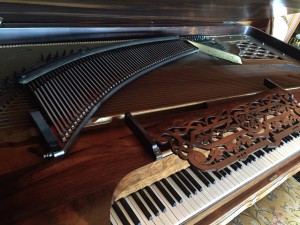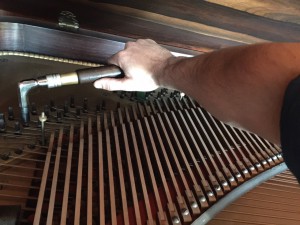There are upright pianos, there are grand pianos, then there are square pianos. They were made from the late 18th century through the 1890’s.
They are beautiful looking instruments, but they are very different than the modern piano. There are less keys, there are only 2 strings per note through the upper range instead of 3, the tension on the strings isn’t as high, the hammers are much thinner and lighter, and most challenging for me, the tuning pins are in the back of the piano instead of the front like the grand piano’s.
There aren’t very many square grands on this side of the states so I don’t get many inquiries about them. I have received several calls from people excited about a “really cool, old square piano that they found pretty cheap” and they want to know if it is worth a lot. They actually aren’t worth very much as instruments, just because the design isn’t nearly as good as the modern grand or upright. But someone recently called asking me to tune their square piano that came with their house. Many piano technicians won’t tune them, but I hadn’t ever done it, so I decided I would help them out and give it a try.

I took a few minutes exploring the piano when I got there. I almost damaged the wall behind the piano when I went to open the lid (about 80 or 90lbs of beautiful Brazilian rosewood) and one of the hinge pins was missing so the lid started to slide off the piano!

I took apart one of my mutes and used the metal rod as a hinge pin while I worked (I have since ordered a wide variety of hinges and pins so I can easily fix issues like that).
Next I had to take parts off the piano until I could actually get to the tuning pins to start tuning. The music rack was screwed in (unlike modern grands), so I took that off. Then I had to dismantle part of the damper system for the bass strings which was covering the tuning pin in the back of the piano. I measured the pitch throughout the piano and it was very flat. Going off what I knew of the piano and my customer, I decided it would be best to play it safe and tune it at a pitch lower than modern A440 in an effort to not break strings (I talked to another tuner later that week and he said he broke 20 strings on the only square grand he ever tried to tune). My post on deciding what pitch to use on older pianos can be found here.
I got to work tuning and it went well! The strings didn’t move very smoothly, so it took several tries on most of the strings to actually get them into tune, but it sounded pretty good when I was finished! Since the tuning pins are in the back, I had to stand, bent 80 degrees at the waist for the full 90 minutes tuning, which was pretty brutal on my back. I kept taking little breaks and lying flat on the floor to rest my back.

The middle section of the piano actually tuned faster than usual because there was only two strings per note instead of the three unison strings found in modern pianos. The highest section of the piano actually had three per note, which is unusual for square grands. The highest section was the hardest and my back was really tired at that point!
I spent about 90 minutes tuning, then played a couple pieces. The touch felt considerably different. The keyboard is actually shorter with 15-20 less keys. The keys themselves are physically smaller, both shorter and narrower than our modern piano keys. They weren’t as narrow as a harpsichord or fortepiano, but they did feel different.
I finished up by replacing a couple tight parts in the damper system that were malfunctioning. By this time in the evening, my customers’ young daughters had come home from school and were very interested in what I was doing. I had to be careful where I set these antique parts as I was working!
The piano played a little heavier than most pianos, but decently. The sound wasn’t as brilliant as we are used to (due to less strings, thinner strings, and lower tension on the strings), but it was pleasing. My customer was happy with an in-tune, well functioning piano when I was done, which is always my goal!
Working the square piano is harder than usual, and I did have to charge a little more than my normal tuning fee, but it wasn’t near the horrible job some piano technicians make it out to be. I would be happy to do it again and I hope I get more chances to work with these interesting instruments.




